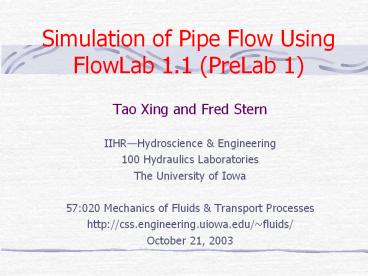Simulation of Pipe Flow Using FlowLab 1.1 (PreLab 1) - PowerPoint PPT Presentation
1 / 24
Title:
Simulation of Pipe Flow Using FlowLab 1.1 (PreLab 1)
Description:
Simulation of Pipe Flow Using FlowLab 1.1 (PreLab 1) Tao Xing and Fred Stern IIHR Hydroscience & Engineering 100 Hydraulics Laboratories The University of Iowa – PowerPoint PPT presentation
Number of Views:61
Avg rating:3.0/5.0
Title: Simulation of Pipe Flow Using FlowLab 1.1 (PreLab 1)
1
Simulation of Pipe Flow Using FlowLab 1.1 (PreLab
1)
- Tao Xing and Fred Stern
- IIHRHydroscience Engineering
- 100 Hydraulics Laboratories
- The University of Iowa
- 57020 Mechanics of Fluids Transport Processes
- http//css.engineering.uiowa.edu/fluids/
- October 21, 2003
2
Outline
- What is FlowLab?
- What can FlowLab do?
- Tutorial for running FlowLab
- EFD data format for FlowLab
- Instructions on setting up parameters
- Other FlowLab functions
- Validation using AFD
From http//www.flowlab.fluent.com
3
What is FlowLab?
- Computational fluid dynamics (CFD) software
package designed to help teach fluid mechanics
and transport phenomena - Based on ready-to-use exercises, FlowLab
eliminates the long learning curve associated
with general fluid flow modeling packages - FlowLab exercises are templates created from
FLUENT and GAMBIT parameterized files - FlowLab templates available in 57020 are pipe
(CFD Lab1) and airfoil flows(CFD Lab2)
4
What can FlowLab do?
- Reinforce basic concepts of fluid mechanics and
heat/mass transfer using computer simulation - Use computing exercises to augment and complement
existing laboratory-based curriculum - Expand the learning experience with real-world
applications of fluid flow and heat/mass transfer
- Expose students to CFD and CFD concepts -- an
increasingly important skill in the job market
5
FlowLab interface
CFD process 16
CFD process step 1, Geometry
Sketch window
Global control buttons
6
CFD process Step 1, Geometry
Units, SI recommended
Reset values to default ones
Create Geometry
Go to CFD process, step 2
You are required to input the minimum parameters
to create the geometry
7
CFD process Step 1, Geometry
Geometry Created
8
CFD process Step 2, Physics
With heat transfer?
9
CFD process Step 2, Physics
10
CFD process Step 2, Physics
11
CFD process Step 2, Physics(BCs details)
When inlet velocity has a distribution
12
CFD process Step 2, Physics(BCs details)
13
CFD process Step 3, Mesh
14
CFD process, step 4, Solve
Stop the calculation to see intermediate results
Calculation will stop if either of the two
parameters satisfied
Time history of residuals
15
CFD process, step 5, Reports
16
CFD process 5, reports (import EFD)
17
Reports (examples of results)
Try to determine the location for the flow to
become fully developed
18
CFD Process, step 6, Post-Processing (Contours)
Choose the contour variables
19
CFD Process, step 6, Post-Processing (vectors)
Choose appropriate scale to view velocity vectors
20
EFD data format for FlowLab
(title "Velocity Magnitude") (labels "Position"
"Velocity Magnitude") ((xy/key/label
"experimental") 0.00 68.25937 0.005 67.16533 0.01
64.64357 0.015 60.6072 0.02 55.80557 0.021
54.26333 0.022 52.45669 0.023 49.98777 0.
024 47.58417 0.025 42.3885 )
Replaced with your own EFD data!
Axial velocity profile
21
Instructions for setting up parameters
- Appropriate set-up of parameters can save both
time and efforts to get the correct results - Iteration number usually set to a large value
(eg. 10000). - The convergence limit for single-precision can
be larger than 10-4, but not lower than 10-5.
No restrictions for double-precision. - The default scale for plotting velocity vectors
is very large, reduce that value to 0.003 or so
for a better view
22
Other functions
Fit the view to full size
Align the geometry with coordinates
23
Validation with AFD
- The pipe template will be validated using the
analytical data for fully developed laminar flows
in pipes - Parameters Pipe radius R0.02647 m
- Pipe length L9.144 m
- Inlet velocity u0.2 m/s
(Re610) - Using Medium mesh and
double precision - Use the equation above to calculate the
analytical velocity distributions and save that
data to a .txt file with the format of FlowLab
requires. - Questions Will the change of the outlet gauge
pressure affect the axial velocity distribution?
Why?
24
Axial velocity profile































